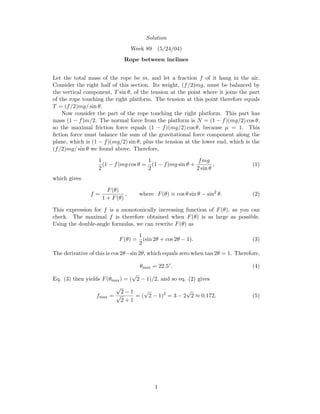Recommended
Recommended
More Related Content
What's hot
What's hot (10)
MTH101 - Calculus and Analytical Geometry- Lecture 37

MTH101 - Calculus and Analytical Geometry- Lecture 37
Similar to Sol89
Similar to Sol89 (19)
Problem 6.64 sace trig t onta Foe-tT is exerted on the object. At t .pdf

Problem 6.64 sace trig t onta Foe-tT is exerted on the object. At t .pdf
More from eli priyatna laidan
More from eli priyatna laidan (20)
Sol89
- 1. Solution Week 89 (5/24/04) Rope between inclines Let the total mass of the rope be m, and let a fraction f of it hang in the air. Consider the right half of this section. Its weight, (f/2)mg, must be balanced by the vertical component, T sin θ, of the tension at the point where it joins the part of the rope touching the right platform. The tension at this point therefore equals T = (f/2)mg/ sin θ. Now consider the part of the rope touching the right platform. This part has mass (1 − f)m/2. The normal force from the platform is N = (1 − f)(mg/2) cos θ, so the maximal friction force equals (1 − f)(mg/2) cos θ, because µ = 1. This fiction force must balance the sum of the gravitational force component along the plane, which is (1 − f)(mg/2) sin θ, plus the tension at the lower end, which is the (f/2)mg/ sin θ we found above. Therefore, 1 2 (1 − f)mg cos θ = 1 2 (1 − f)mg sin θ + fmg 2 sin θ , (1) which gives f = F(θ) 1 + F(θ) , where F(θ) ≡ cos θ sin θ − sin2 θ. (2) This expression for f is a monotonically increasing function of F(θ), as you can check. The maximal f is therefore obtained when F(θ) is as large as possible. Using the double-angle formulas, we can rewrite F(θ) as F(θ) = 1 2 (sin 2θ + cos 2θ − 1). (3) The derivative of this is cos 2θ−sin 2θ, which equals zero when tan 2θ = 1. Therefore, θmax = 22.5◦ . (4) Eq. (3) then yields F(θmax) = ( √ 2 − 1)/2, and so eq. (2) gives fmax = √ 2 − 1 √ 2 + 1 = ( √ 2 − 1)2 = 3 − 2 √ 2 ≈ 0.172. (5) 1

